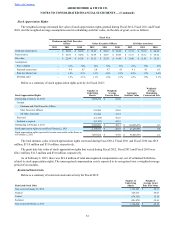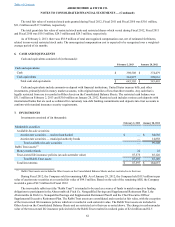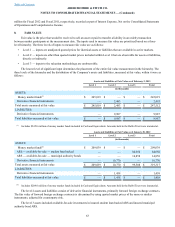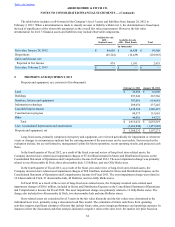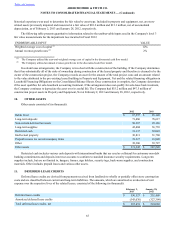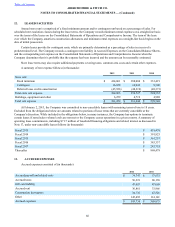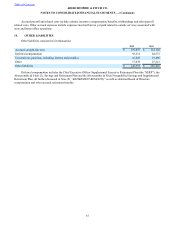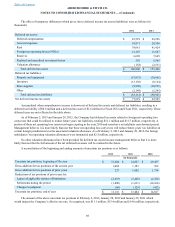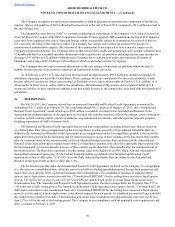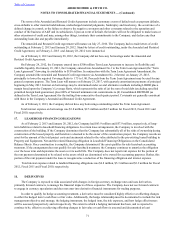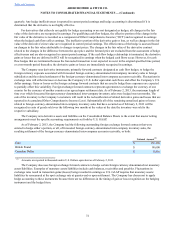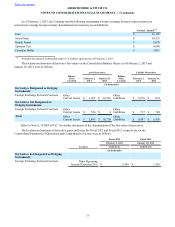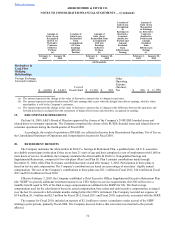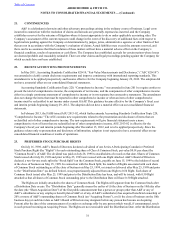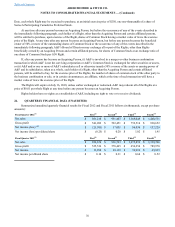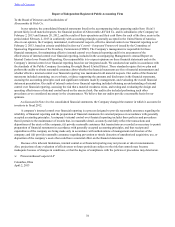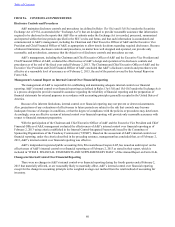Abercrombie & Fitch 2013 Annual Report Download - page 71
Download and view the complete annual report
Please find page 71 of the 2013 Abercrombie & Fitch annual report below. You can navigate through the pages in the report by either clicking on the pages listed below, or by using the keyword search tool below to find specific information within the annual report.
71
The terms of the Amended and Restated Credit Agreement include customary events of default such as payment defaults,
cross-defaults to other material indebtedness, undischarged material judgments, bankruptcy and insolvency, the occurrence of a
defined change in control, or the failure to observe the negative covenants and other covenants related to the operation and
conduct of the business of A&F and its subsidiaries. Upon an event of default, the lenders will not be obligated to make loans or
other extensions of credit and may, among other things, terminate their commitments to the Company, and declare any then
outstanding loans due and payable immediately.
The Amended and Restated Credit Agreement will mature on July 27, 2016. The Company had no trade letters of credit
outstanding at February 2, 2013 and January 28, 2012. Stand-by letters of credit outstanding, under the Amended and Restated
Credit Agreement, on February 2, 2013 and January 28, 2012 were immaterial.
As of February 2, 2013 and January 28, 2012, the Company did not have any borrowings under the Amended and
Restated Credit Agreement.
On February 24, 2012, the Company entered into a $300 million Term Loan Agreement to increase its flexibility and
available liquidity. On January 23, 2013, the Company entered into Amendment No.1 to the Term Loan Agreement (the "Term
Loan Agreement") lowering its availability to $150 million. In conjunction with the Term Loan Agreement Amendment, the
Company amended the Amended and Restated Credit Agreement (via Amendment No. 2 thereto) on January 23, 2013,
principally to lower the required Coverage Ratio to 1.75 to 1.00. Proceeds from the Term Loan Agreement may be used for any
general corporate purpose. The Term Loan will mature on February 23, 2017, with quarterly amortization payments of principal
beginning in May 2013. Interest on borrowings may be determined under several alternative methods including LIBOR plus a
margin based upon the Company’s Leverage Ratio, which represents the ratio of (a) the sum of total debt (excluding specified
permitted foreign bank guarantees) plus 600% of forward minimum rent commitments to (b) Consolidated EBITDAR (as
defined in the Term Loan Agreement) for the trailing four-consecutive-fiscal-quarter period. Covenants are generally consistent
with those in the Company’s Amended and Restated Credit Agreement.
As of February 2, 2013, the Company did not have any borrowings outstanding under the Term Loan Agreement.
Total interest expense on borrowings was $3.8 million, $2.5 million and $4.5 million for Fiscal 2012, Fiscal 2011 and
Fiscal 2010, respectively.
17. LEASEHOLD FINANCING OBLIGATIONS
As of February 2, 2013 and January 28, 2012, the Company had $63.9 million and $57.9 million, respectively, of long-
term liabilities related to leasehold financing obligations. In certain lease arrangements, the Company is involved with the
construction of the building. If the Company determines that the Company has substantially all of the risks of ownership during
construction of the leased property and therefore is deemed to be the owner of the construction project, the Company records an
asset for the amount of the total project costs and an amount related to the value attributed to the pre-existing leased building in
Property and Equipment, Net and the related financing obligation in Leasehold Financing Obligations on the Consolidated
Balance Sheets. Once construction is complete, the Company determines if the asset qualifies for sale-leaseback accounting
treatment. If the arrangement does not qualify for sale-leaseback treatment, the Company continues to amortize the obligation
over the lease term and depreciates the asset over its useful life. The Company does not report rent expense for the portion of
the rent payment determined to be related to the assets which are determined to be owned for accounting purposes. Rather, this
portion of the rent payment under the lease is recognized as a reduction of the financing obligation and interest expense.
Total interest expense related to landlord financing obligations was $6.8 million, $5.3 million and $3.3 million for Fiscal
2012, Fiscal 2011 and Fiscal 2010, respectively.
18. DERIVATIVES
The Company is exposed to risks associated with changes in foreign currency exchange rates and uses derivatives,
primarily forward contracts, to manage the financial impacts of these exposures. The Company does not use forward contracts
to engage in currency speculation and does not enter into derivative financial instruments for trading purposes.
In order to qualify for hedge accounting treatment, a derivative must be considered highly effective at offsetting changes
in either the hedged item’s cash flows or fair value. Additionally, the hedge relationship must be documented to include the risk
management objective and strategy, the hedging instrument, the hedged item, the risk exposure, and how hedge effectiveness
will be assessed prospectively and retrospectively. The extent to which a hedging instrument has been, and is expected to
continue to be, effective at achieving offsetting changes in fair value or cash flows is assessed and documented at least
Table of Contents ABERCROMBIE & FITCH CO.
NOTES TO CONSOLIDATED FINANCIAL STATEMENTS — (Continued)


